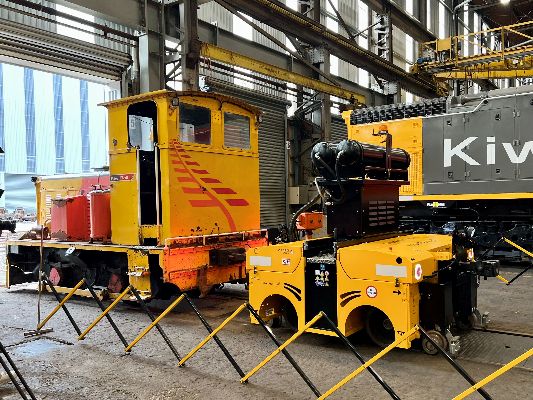KiwiRail’s Oldest Locomotive Retires
The replacement of KiwiRail’s oldest diesel shunt locomotive with a modern, zero-emissions equivalent symbolises the transformation going on in KiwiRail, Acting Chief Executive David Gordon says.

Transport Minister Michael Wood and Climate Change Minister James Shaw joined KiwiRail staff and other guests at a small event in Wellington’s Hutt Workshops this morning to mark the retirement of the 85-year-old shunt engine TR56.
It is being replaced by a new, battery-powered shunt, as part of the Government’s $1.6 billion investment in replacing KiwiRail’s aging locomotives and wagons, and upgrading mechanical facilities.
“TR56 began working in New Zealand in 1936, and since the late-1960s has been based at Hutt Workshops – bringing locomotives, carriages and wagons onto and off the shop floor. It has served us well all those years but we have moved into a new era,” Mr Gordon says.
“Its replacement offers improved control and safety, and is fully electric. It is part of a renewal across KiwiRail that is preparing us for a low carbon future.”
Mr Gordon says diesel trains already have 70 per cent fewer emissions than heavy trucks, per tonne of freight carried. However, KiwiRail was focused on further reducing its environmental footprint.
“Like the Government, we are aiming to be net zero carbon by 2050 and, as a start, we are committed to reducing our overall emissions 30 per cent by 2030.
“Government support is helping us to do this by funding the renewal of our aging fleet of locomotives and Interislander ferries with more efficient, low-emission replacements.
“Rail currently only carries about 12 per cent of New Zealand’s freight task. If we want to reduce transport emissions, rail needs to carry more. New, low emission locomotives and ferries will improve service reliability and encourage more Kiwi businesses to put their goods on rail.”
Lower emissions investments include:
- KiwiRail has received 14 new 300 tonne battery powered shunts and 2 new 110 tonne shunts, for use in workshops, and is currently working towards the purchase of at least 35 larger shunt engines, with the aim of them being electric or hybrid-diesel.
- KiwiRail has signed a contract with Spain-based manufacturers Stadler for 57 fuel-efficient, low-emission locomotives for the South Island. They will be built to the highest (Stage 5) European emissions standard and are expected to begin arriving in 2024.
- KiwiRail is upgrading and extending the life of many of the North Island electric locomotives, which run between Hamilton and Palmerston North.
- KiwiRail has signed a contract with South Korea’s Hyundai Mipo Dockyard to build two large, rail enabled ferries to replace the current Interislander fleet. These new ferries will make use of batteries and onshore charging to cut current ferry emissions by 40 per cent. The ferries are expected to arrive in New Zealand in 2025 and 2026.
The retired shunt locomotive, TR56, is being gifted to the Rail Heritage Trust of New Zealand, who
will lease it to Silverstream Railway in Upper Hutt. It will be used to pull passenger carriages on the short section of line the heritage railway owns.


 School Lunch Collective: Compass Group New Zealand To Acquire Libelle Group Securing Healthy School Lunch Programme
School Lunch Collective: Compass Group New Zealand To Acquire Libelle Group Securing Healthy School Lunch Programme PSA: PPPs Pose Risks To New Zealand Workers
PSA: PPPs Pose Risks To New Zealand Workers Office of the Privacy Commissioner: New Research Shows Business Leaders Fear Being On The Hook For Others’ Privacy Breaches
Office of the Privacy Commissioner: New Research Shows Business Leaders Fear Being On The Hook For Others’ Privacy Breaches E Tū: E Tū Members Send Open Letter To James Grenon And NZME Board
E Tū: E Tū Members Send Open Letter To James Grenon And NZME Board Commerce Commission: Commission Calls For Comments On Copper Access Deregulation
Commerce Commission: Commission Calls For Comments On Copper Access Deregulation New Zealand Association of Scientists: NZAS Supports Saving Biotechnology Capacity In Callaghan; Asks What Now For Applied Technology Group
New Zealand Association of Scientists: NZAS Supports Saving Biotechnology Capacity In Callaghan; Asks What Now For Applied Technology Group



